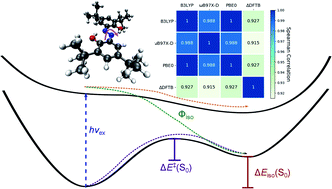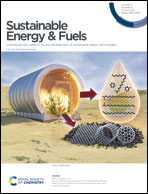Multifactor theoretical modeling of solar thermal fuels built on azobenzene and norbornadiene scaffolds†
Abstract
Solar thermal fuels (STFs) offer a unique way of harnessing energy from the sun by absorbing photons and storing the energy in a metastable photoisomerized state. The reverse isomerization process can then be catalytically or thermally triggered to release the stored energy and return the fuel to its stable configuration. Functionalization of these compounds is necessary to reach practical energy storage densities, but substitutions that increase the energy storage density may adversely impact performance at other steps along the fuel cycle. Recent computational screening efforts to identify high-performance STF candidates have focused on properties that can be estimated from ground-state electronic structure methods. Here we argue that computational screening of STF candidates across the full fuel cycle benefits from a multifactor approach with excited-state properties like excitation energies and photoisomerization quantum yields addressed alongside key ground-state properties like energy storage densities and reverse isomerization barriers. As a critical step toward multifactor high-throughput screening and optimization of STFs, in this work we first systematically simulate the specific storage energy and excitation energy of substituted azobenzene- and norbornadiene-based STFs through electronic structure calculations. Density-functional tight-binding (DFTB) predictions are benchmarked against density functional theory (DFT) and experimental measurements where available. To encompass the complete solar thermal fuel cycle in these compounds, we then apply DFT methods to analyze the reverse isomerization process and its relationship to the photoisomerization quantum yield. We find that DFTB provides a useful balance between accuracy and computational efficiency for virtual screening of STF photoabsorption and energy storage, while isomerization barrier and quantum yield predictions require more sophisticated approaches.



 Please wait while we load your content...
Please wait while we load your content...